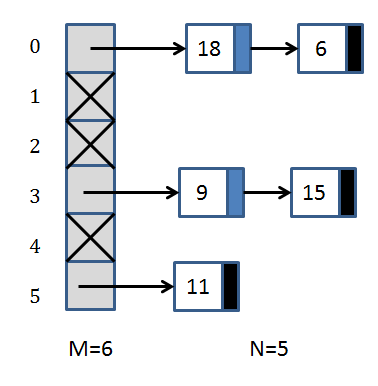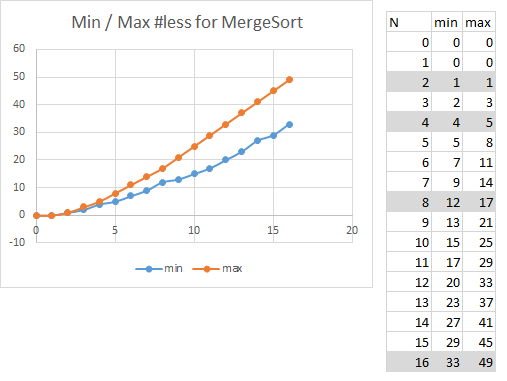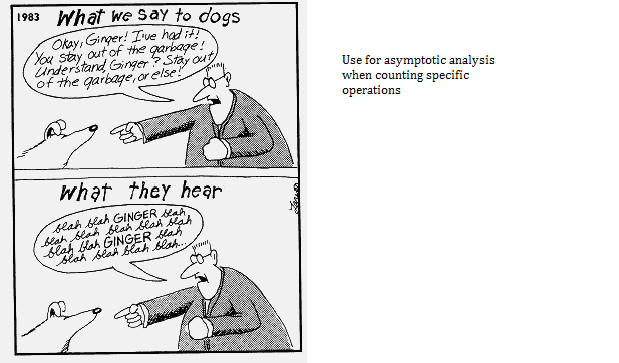CS 2223 Mar 29 2022
Daily Exercise:
Classical selection: Mendelssohn Violin Concerto E Minor Op.64 (1844)
Musical Selection:
Prince: Purple Rain (1984)
Visual Selection:
Les
Raboteurs (the floor scrapers), Gustave Caillebotte (1876)
Live Selection:
Crazy on you,
Heart (1975)
Daily Question: DAY10 (Problem Set DAY10)
1 Hashing With Separate Chaining
1.1 Homework1
The average HW1 for the past few offerings is:
2015 - 87.5
2018 - 91.5
2019 - 83.2
2020 - 82.0
2021 - 87.6
2022 - 75.8
As last week progressed and I met with more students during office hours, I sensed that I needed to modify my approach for HW2. There are fewer problems on HW2, but the core problem (RangeList) still remains the most challenging to complete.
1.2 Recurrence Relations
I have prepared two documents showing how I compute these recurrence relationships. Note that the homework is more complicated, so start with these to make sure you understand the technique.
Recursive Max - # times less is invoked to find largest value.
Find these files in Canvas | Files | in-class exercises and there are two files labeled "day 10".
1.3 Lecture
For one wild, glad moment we snapped the chain that binds us to earth, and joining hands with the winds we felt ourselves divine...
The Story of My Life
Helen Keller
The Symbol Table (introduced last lecture) represents the ability to store a collection of values to be associated with a given key. The initial implementation stored all (key, value) pairs in a single linked list. This leads to inefficient performance when an increasing number of elements are being stored.
Specifically, when retrieving (get) or inserting (put) a value into the Symbol Table, the performance was directly proportional to the number of elements already stored by the Symbol Table.
We need some way to reduce the length of the linked lists. One solution that works very well in practice is to use a hash function to uniformly partition the keys into different linked lists. This is the intuition and basis for Hashing.
So we start not with a single linked list, but an array of SequentialSearchST objects as we introduced in last lecture. The question remains, however, as to how to partition the keys. The common way to do this is to develop some hashCode method that returns an integer based on the contents of a specific value.
The following is a sample hashCode method for the java.lang.String class:
public int hashCode() { int h = hash; if (h == 0 && value.length > 0) { char val[] = value; for (int i = 0; i < value.length; i++) { h = 31 * h + val[i]; } hash = h; } return h; }
This computed hash value is not guaranteed to be unique. There may be multiple keys that hash to the exact same value. However it is essential that if two key values are equal to each other, then they produce the same hash code.
For those of you interested in cybersecurity, having a repeatable hash function is a security risk.
Hello gives 69609650 aaaaaa gives -1425372064
As you can see, sometimes hashCode returns a negative number, because of mathematical overflow – note that hashCode returns an integer.
Now comes the premise, if this hashCode method does a good job in generating uniform integers, then you can create separate SequentialSearchST objects into which to add the (key, value) pairs. But how many objects should we create initially? Instead of worrying too much about that question, start with an initial number, and then resize as needed if the performance begins to suffer.
We are now ready to review the code.
public class SeparateChainingHashST<Key, Value> { int N; // number of key-value pairs int M; // hash table size SequentialSearchST<Key, Value>[] st; // array of symbol tables int INIT_CAPACITY = 4; // initial size int AVG_LENGTH = 7; // Threshold to resize /** Initialize empty symbol table with <tt>M</tt> chains. */ public SeparateChainingHashST(int M) { this.M = M; st = (SequentialSearchST<Key, Value>[]) new SequentialSearchST[M]; for (int i = 0; i < M; i++) { st[i] = new SequentialSearchST<Key, Value>(); } } /** Choose initial default size. */ public SeparateChainingHashST() { this(INIT_CAPACITY); } /** Convert hashCode() into index between 0 and M-1 */ int hash(Key key) { return (key.hashCode() & 0x7fffffff) % M; } public int size() { return N; } public boolean isEmpty() { return size() == 0; } public boolean contains(Key key) { return get(key) != null; } public Value get(Key key) { int i = hash(key); return st[i].get(key); } public void put(Key key, Value val) { // double table size if average length of list >= AVG_LENGTH if (N >= AVG_LENGTH*M) resize(2*M); int i = hash(key); if (!st[i].contains(key)) N++; st[i].put(key, val); } }
Important Note: This code is not as efficient as it could be. Discussion Here and explain how this should be different, though it means modifying SequentialSearchST.
After a few insertions into a table with M=6 separate chains (you might hear me say the word "bin" or "bucket" since those are common in the literature) you could have the following situation:
 In this case, the hash function is simply "compute modulo 6 of the value
being inserted".
In this case, the hash function is simply "compute modulo 6 of the value
being inserted".
1.4 How To Scale
Assuming that the hash uniformly distributes key values, this code improves the performance of each operation.
Specifically, when retrieving (get) or inserting (put) a value into the Symbol Table, the performance is now directly proportional to N/M
However, if you do nothing to change the number of M separate chains, you will eventually have decreasing performance, because N will be substantially greater than M.
Much like you have seen before, you need to resize the array of separate chains. However, what to do with the elements that have already been placed into the hash table? It turns out that you have to take a substantial performance penalty hit and reinsert all elements in the hashtable because they may end up in a different index because the value of the hash function is dependent on M.
The following resize method takes advantage of the existing constructor to simplify its implementation. Once done, it updates the st[] array to use the newly created one.
void resize(int chains) { SeparateChainingHashST<Key, Value> temp = new SeparateChainingHashST<Key, Value>(chains); for (int i = 0; i < M; i++) { SequentialSearchST<Key,Value>.Node node = st[i].first; while (node != null) { temp.put(node.key, node.value); node = node.next; } } M = temp.M; N = temp.N; st = temp.st; }
1.5 Demonstration
If you run the SeparateChainingHashST sample code, you will see the following output:
2015 213557 words in the hash table. Table has 45056 indices. there are 392 empty indices 99.1299715909091% maximum chain is 16 number of single is 1841 THIS YEAR 321129 words in the hash table. Table has 49151 indices. there are 79 empty indices 99.8392708184981% maximum chain is 19 number of single is 473
Note the average number one would expect in a chain is 213557/45056 (4.74) in 2015, or 321129/49151 (6.5) this year, which is impressive!
These results are incredibly promising! You can determine if an item exists in the Hash Table using no more than 19 comparisons. Of course, the memory requirements are noticeable, but you have to admit this is very nice.
Let’s look at these numbers in a bit more detail:

In this chart, the x-axis represents the size of an individual chain, and the y-axis counts then number of chains in the Hash Table with this given size. The blue line represents the actual results, while the orange curve models a normal distribution with a mean of 6 and stdev of 2.
As you can see there is a "longer tail" on the actual results, which suggests the normal distribution undercounts the number of chains that are long.
There is a direct comparison to make with using Binary Array Search over a sorted array. First, you would have to sort all strings and construct an array for them. Thereafter, the maximum number of comparisons to locate an entry would be 1 + Floor(log 321129) or 1 + Floor(18.29279) = 19.
This exercise demonstrates that using additional space can help improve performance.
1.6 Bad Hashing
What if the hash doesn’t do a good job in distributing the values? For example, consider hashing based solely on the first character of the String key value:
public int hash(Key key) { return ((String) key).charAt(0) % M; }
This would result in:
Elapsed time 110.77 seconds 321129 words in the hash table. Table has 49151 indices. there are 49125 empty indices 0.05289821163353414% maximum chain is 34638 number of single is 0 size distribution:[49125, 0, 0, 0, 0, 0, 0, 0, 0, 0, 0, 0, 0, 0, 0, 0, 0, 0, 0, 0, 0, 0, 0, 0, 0, 0, 0, 0, 0, 0] number of excessive:26
1.7 Accounting BinaryArraySearch inspections
We have only referred to "log N + 1" for number of comparisons to make when performing Binary Array Search on an ordered collection of N values.
What if N is not a power of 2? The formula changes just slightly, to be 1 + Floor(log N)". In fact, the worst case for Binary Array Search occurs when N is exactly a power of 2 and the best case occurs when N=2k-1. It’s all in the mathematics.
1.8 Counting #less for Merge Sort
When reviewing the fine-grained behavior of MergeSort, there is "noise" in the data, which can be eliminated by focusing on problem instance input sizes where N is a power of two.

Look at the selected regions for N=2k and you can see that the empirical results confirm the following formula for N >=4. The most number of less comparisons used by Merge Sort is N*log(N)-N+1. What is the big O notation for this formula? Since N*log(N) will dominate the subtraction of N, the growth for this formula is O(N log N).
1.9 Improved O(...) Explanation

Sometimes when we do O() anlaysis, the goal is to analyze running time performance.
Sometimes we count the number of key operations. Other times, we look at space utilization.
1.10 Sample Exam Question
A researcher proposes to design a data type which consiststs of a linear linked list of nodes, each of which stores an array of K individual comparable items in sorted order. Only the last node in the list may contain fewer than K items. This data type will offer the following operations:
insert (v) – insert v into the collection
remove (v) – remove v from the collection
contains(v) – check whether collection contains v
He claims he needs ~ log(N*K) performance for determining whether the collection contains a given element.
From this idea, there are several possible questions to ask:
Start with the contains method. Come up with an algorithm for this method. What is the performance of your method?
Is his performance claim correct?
Write pseudo code for insert.
Write pseudo code for remove.
1.11 Daily Question
The assigned daily question is DAY10 (Problem Set DAY10)
If you have any trouble accessing this question, please let me know immediately on discord.
1.12 Version : 2022/03/31
(c) 2022, George T. Heineman
